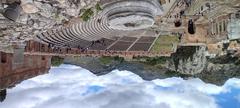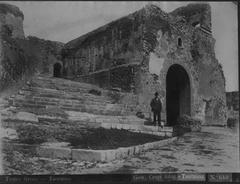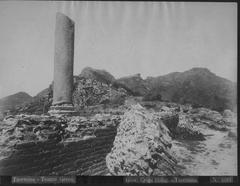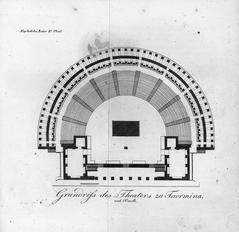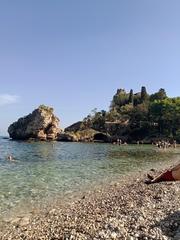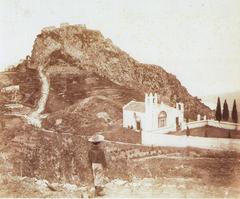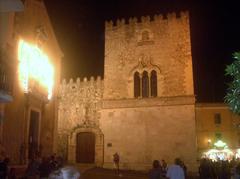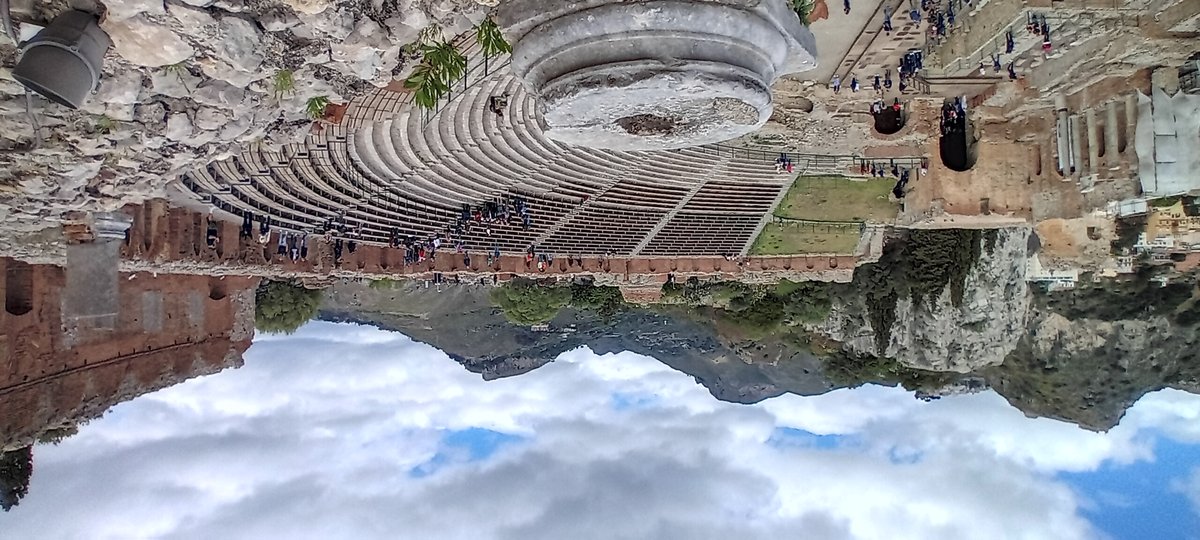
Teatro Greco Taormina: Visiting Hours, Tickets, and Historical Insights
Published Date: 17/07/2024
Introduction to Teatro Greco in Taormina
Nestled in the picturesque town of Taormina, Sicily, the Teatro Greco, or Greek Theatre, stands as a testament to the rich cultural and architectural heritage of ancient civilizations. Built during the 3rd century BCE by the Greeks and later expanded by the Romans, this ancient structure showcases the ingenuity of both civilizations (source). The Teatro Greco is an architectural marvel featuring a semi-circular design that provides excellent acoustics and a breathtaking backdrop of Mount Etna and the Ionian Sea, making it a must-visit destination for history buffs, architecture enthusiasts, and travelers seeking stunning views (source). This guide aims to offer a comprehensive look at the Teatro Greco’s history, architectural features, cultural significance, and practical information for visitors, including ticket prices, visiting hours, and travel tips. Whether you are planning your first visit or returning to explore more, this guide will ensure you have all the information you need for a memorable experience.
Table of Contents
- Introduction
- History of Teatro Greco
- Cultural Significance
- Visitor Information
- Preservation and Restoration
- Key Historical Events
- Archaeological Discoveries
- Influence on Modern Theatre
- Special Events and Guided Tours
- Photographic Spots
- FAQ
- Conclusion
History of Teatro Greco
Origins and Construction
The Teatro Greco, or Greek Theatre, in Taormina, Italy, is one of the most significant and well-preserved ancient structures in Sicily. Its origins date back to the 3rd century BCE, during the Hellenistic period when the Greeks colonized Sicily. The theatre was initially constructed by the Greeks, who were known for their architectural prowess and cultural contributions. The original structure was relatively modest, built primarily for dramatic performances and public gatherings.
Roman Renovations
In the 2nd century CE, the theatre underwent significant renovations under Roman rule. The Romans expanded and modified the theatre to accommodate a larger audience and to host a variety of events, including gladiatorial contests and naval battles. The Romans added a grand scenae frons (stage front) and an elaborate cavea (seating area), which could hold up to 5,000 spectators. The use of brick and concrete in the construction during this period is a testament to Roman engineering skills (source).
Architectural Features
The Teatro Greco is renowned for its architectural features, which reflect a blend of Greek and Roman styles. The theatre’s semi-circular design, typical of Greek theatres, provides excellent acoustics, allowing even the faintest sounds to reach the upper tiers. The Roman influence is evident in the use of arches and vaults, which support the structure and enhance its durability. The theatre’s location on a hillside offers a breathtaking backdrop of Mount Etna and the Ionian Sea, adding to its allure (source).
Cultural Significance
Throughout its history, the Teatro Greco has been a cultural hub, hosting a variety of performances and events. In ancient times, it was a venue for Greek tragedies and comedies, which were integral to Greek culture and education. The Romans expanded its use to include more diverse forms of entertainment, reflecting their broader cultural tastes. The theatre’s enduring significance is evident in its continued use for cultural events, including the annual Taormina Film Fest, which attracts international artists and audiences (source).
Visitor Information
Tickets and Visiting Hours
The Teatro Greco is open to visitors year-round. Visiting hours typically range from 9 AM to 7 PM, but it’s advisable to check the official website for any seasonal changes or special events. Tickets can be purchased at the entrance or online, with prices varying based on age and group size. Discounts are often available for students, seniors, and children.
Travel Tips
- Best Time to Visit: Early morning or late afternoon to avoid crowds and enjoy the best lighting for photography.
- Getting There: Taormina is accessible by train, bus, or car. Parking is available near the theatre, but spaces can be limited during peak tourist season.
- Nearby Attractions: The Ancient Theatre is close to other historical sites such as the Roman Odeon and the Palazzo Corvaja. Visitors can also enjoy the scenic views from the nearby Villa Comunale gardens.
Preservation and Restoration
The Teatro Greco has undergone several preservation and restoration efforts to maintain its structural integrity and historical authenticity. In the 19th century, the theatre was rediscovered and excavated by European archaeologists, who recognized its historical value. Since then, various restoration projects have been undertaken to repair damage caused by natural wear and human activity. Modern conservation techniques have been employed to stabilize the structure and protect it from environmental factors, ensuring that it remains a testament to ancient engineering and cultural heritage (source).
Key Historical Events
Several key historical events have shaped the history of the Teatro Greco. During the Byzantine period, the theatre was repurposed as a fortress, reflecting the changing political and military landscape of the region. In the Middle Ages, it fell into disuse and was partially buried by debris and vegetation. The theatre’s rediscovery in the 18th century sparked renewed interest in its preservation and study, leading to its current status as a protected archaeological site (source).
Archaeological Discoveries
Archaeological excavations at the Teatro Greco have uncovered a wealth of artifacts and structural details that provide insights into its construction and use. These discoveries include fragments of statues, inscriptions, and decorative elements that reveal the artistic and cultural influences of the period. The excavations have also shed light on the engineering techniques used by the Greeks and Romans, highlighting their ingenuity and craftsmanship (source).
Influence on Modern Theatre
The design and acoustics of the Teatro Greco have influenced modern theatre architecture, demonstrating the enduring legacy of ancient engineering. The theatre’s semi-circular layout and tiered seating have been emulated in contemporary performance spaces, reflecting the timeless principles of design and audience engagement. The Teatro Greco’s ability to host a wide range of performances, from classical plays to modern concerts, underscores its versatility and relevance in the modern era (source).
Special Events and Guided Tours
The Teatro Greco hosts various special events throughout the year, including the renowned Taormina Film Fest. Guided tours are available for those who wish to delve deeper into the theatre’s history and architectural features. These tours are often led by knowledgeable guides who can provide fascinating insights and anecdotes about the site.
Photographic Spots
For photography enthusiasts, the Teatro Greco offers numerous picturesque spots. The view of Mount Etna from the theatre is particularly stunning, especially during sunrise and sunset. The ancient columns and arches also provide excellent backdrops for capturing the essence of this historical site.
FAQ
Q: What are the opening hours for Teatro Greco? A: The Teatro Greco is typically open from 9 AM to 7 PM. However, hours may vary, so it’s best to check the official website before planning your visit.
Q: How much do tickets to Teatro Greco cost? A: Ticket prices vary depending on age and group size. Discounts are available for students, seniors, and children. It’s advisable to purchase tickets online for convenience and to check for any available discounts.
Q: Is the Teatro Greco accessible for people with disabilities? A: While the site has some uneven terrain and steps, there are areas that are accessible to visitors with disabilities. It’s recommended to contact the site in advance to arrange for any special accommodations.
Conclusion
The Teatro Greco in Taormina stands as a monument to the artistic and engineering achievements of ancient civilizations. Its rich history, architectural splendor, and cultural significance make it a must-visit destination for anyone interested in the heritage of Sicily and the broader Mediterranean world. The theatre’s ongoing preservation and use for cultural events ensure that it remains a vibrant and enduring symbol of human creativity and ingenuity. Plan your visit today to experience the timeless allure of the Teatro Greco.
For more information and to stay updated on events, follow us on social media and download the Audiala mobile app. Explore related articles and discover more about Sicily’s historical treasures.
